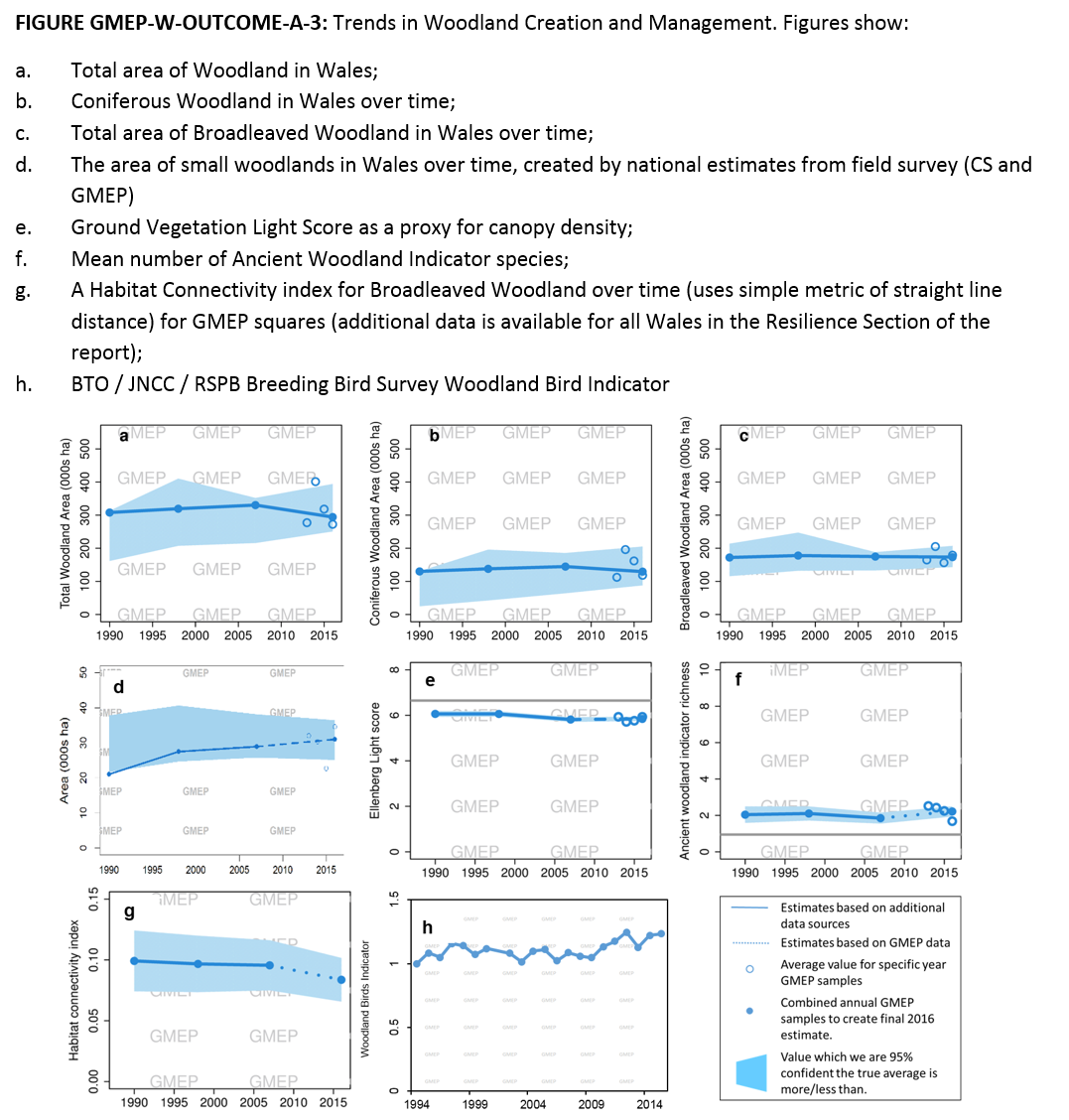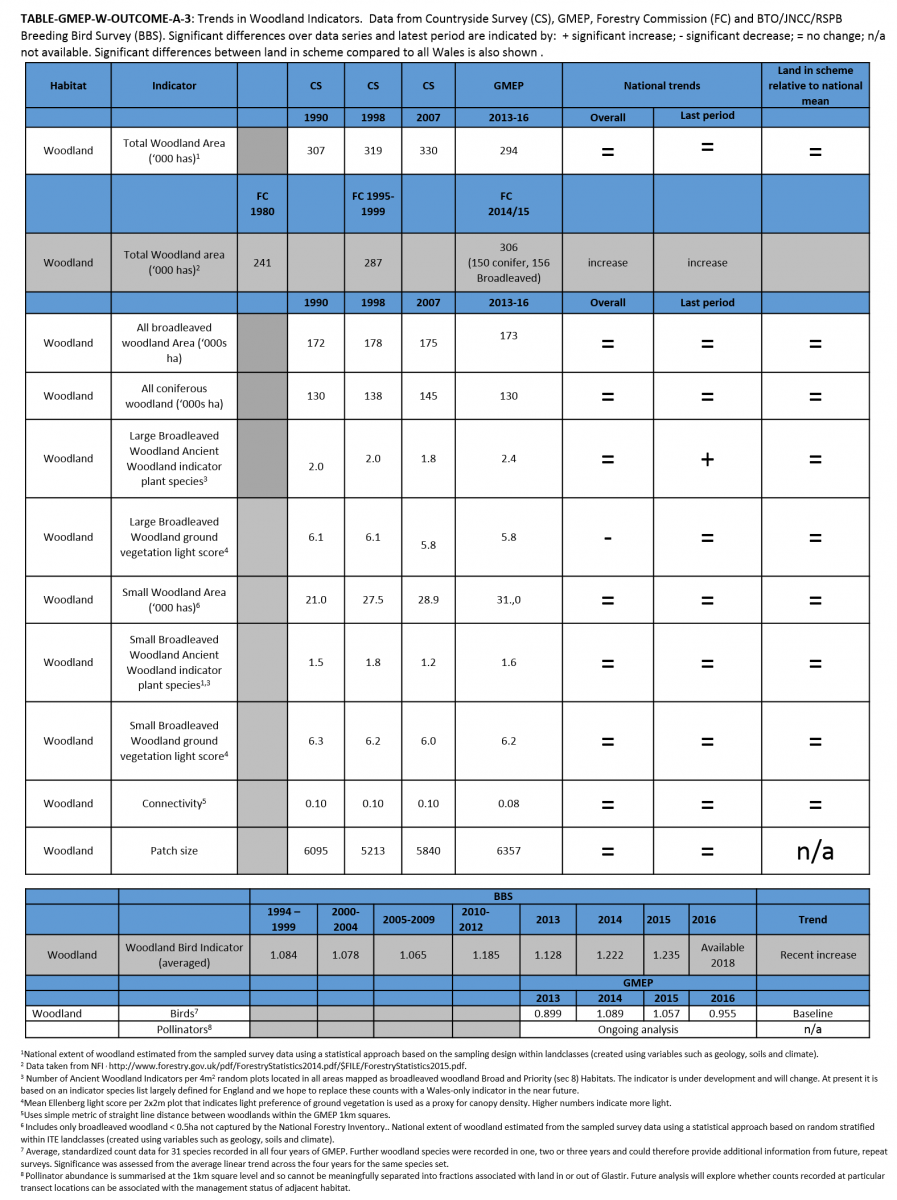Available Translations:
Summary of GMEP results by Glastir Outcome
A wide range of results are now available from the GMEP project. These provide evidence of ongoing changes in Wales' Natural Resources. A subset of results has been agreed with the Welsh Government and the GMEP Advisory Group as high level indicators for the 6 Outcomes of the Glastir Scheme and are reported here. The six outcomes are:
- Combating climate change
- Improving water quality and managing water resources
- Improving soil quality and management
- Maintaining and enhancing biodiversity
- Managing landscapes and historic environment and improving public access to the countryside
- Woodland creation and management
GMEP activities have included; a national rolling field survey of 300 1km squares with an equal split of land in and out of scheme; new analyses of long term data from other monitoring programmes; development of new indicators; modelling to explore potential future outcomes; surveys to assess wider socio-economic benefits; and exploitation and development of novel technologies.
These indicators are included in the Headline Results below to give a broad summary of the significant findings of GMEP as either 'positive outcomes' or 'areas of concern or a need for further action'.
Headline Results: Glastir Impacts
GMEP was tasked with providing a baseline for assessing the future impacts of Glastir. Future field surveys will provide the main evidence for actual change in the six original intended Outcomes. To provide an early insight into likely future impacts on the six original Outcomes intended for Glastir, we exploited a set of models and accounting tools to project the likely impacts of management interventions for soil, water, biodiversity, climate change and woodlands.
Woodland creation and management
Positive Outcomes: Glastir Impacts
- 11% (Entry) or 20% (Advanced) increase in the number of farms restoring or creating woodland in the past three years compared to non-scheme farms.
- Woodlands were more likely to be managed for 'wildlife habitat' rather than 'shelter for livestock' if farms were in the Advanced level of Glastir.
Areas for concern or further action needed: Glastir Impacts
GMEP modelling results with respect to increased habitat for woodland species, carbon sequestration and runoff mitigation resulting from woodland creation and management are all low reflecting the known low uptake of Glastir woodland options.
- A relatively small 3% increase in area accessible to broadleaved woodland species by the end of 2016 is projected by the LUCI model in response to prescriptions included in Glastir contracts.
- Barriers to uptake of Glastir Woodland Creation and Management Scheme were explored using the Farmer Practice Survey, focus groups and a series of structured interviews. The main reasons for not taking up a grant for woodland management, after a general "not interested in woodland management", included "lack of available land" (29%), "insufficient time to diversify" (28%), "insufficient knowledge or equipment" (28%) and the "scheme was too complicated" (27%).
- Recommendations to remove scheme barriers are:
- Application process should be simplified as operation prescriptions are a barrier
- Scheme needs to be more flexible to account for external influences
- Auditing process is complex. Penalties need to be clearer and the auditing process less threatening
- Payment rates are obscure. There is confusion about what is covered and the rates for contractual labour
Detailed findings: Glastir impacts
For more detail on data and findings related to Glastir impacts, visit the Resources page and download the GMEP Final Report or the GMEP Final Report Executive Summary.
Headline Results: National Trends
The GMEP 'Wider Wales' structured rolling field survey provides the control population for assessing future changes resulting from Glastir. One benefit of the structured sampling of the countryside used in this Wider Wales survey is that this control population also provides an unbiased national assessment of stock and condition of common habitats and species including woodland, soils, small streams and ponds. GMEP results can be linked to past trends to put the current observations into context.
Woodland creation and management
Positive Outcomes: National Trends
- There has been an improvement in the plants indicative of good condition in large broadleaved woodlands over the last 10 years suggesting improved management.
- There has been a recent increase in the BTO/JNCC/RSPB Breeding Bird Survey Woodland Bird Indicator.
- Stability in all other condition metrics including connectivity, patch size and light/shade index in last 10 years.
Areas for concern or further action needed: National Trends
- No change in the area of small woodlands (< 0.5ha). The small amount of area planted within the scheme (3,923 ha) is within the variability of the GMEP sample. These small woodlands are not currently captured by the National Forest Inventory and are the woodlands most likely to be affected by Glastir. This does not appear to reflect the ambitious targets for expansion of woodlands set by the Welsh Government nor exploit the multiple benefits woodlands can bring for biodiversity, carbon sequestration and water regulation.
Detailed findings: National Trends
Further information on National Trends in high level GMEP indicators is available in the figures and tables below. For more detail on data and findings related to National Trends, visit the Resources page and download the GMEP Final Report or the GMEP Final Report Executive Summary.



